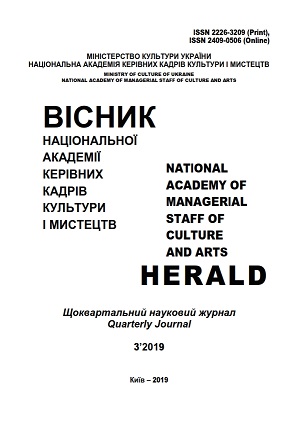Становлення «простого» стилю в композиторській творчості другої половини ХХ - початку ХХІ ст.
Formation of “Simple” Style in Composition Creativity of the Second Half of the XX - Beginning of the XXI Century
Author(s): Anton TrofimovSubject(s): Music, Aesthetics, Recent History (1900 till today), History of Art
Published by: Національна академія керівних кадрів культури і мистецтв
Keywords: musical art; style; musical style; simple style; composer; composing;
Summary/Abstract: The purpose of the article is to formulate the appropriate picture of the ―simple‖ style in the Music Art of the second half of the 20 and the early of the 21st century on the basis of the scientific definitions of the musical style at the beginning of the 21st century. Methodology. The appeal to the problematic of musical style has the interdisciplinary nature and requires a complex approach that brings the traditional aspects of art studies and the general humanitarian aspects of this scientific work together. On the one side, we use the methodology of musical studies which allows us to focus on the musical approach itself. On the other side we appeal to general art studies and aesthetical philosophic studies that are dedicated to the problems of the postmodern and its ideological base, and this allows us to understand and to assess the processes that take their places in modern art space. The scientific novelty of the research lies in the consideration of the ―simple‖ style of the composer artwork during the second half of the 20th century and the beginning of the 21st century. This style has its own specific features and peculiarities of the interactions between the ideological figurative system and composition techniques. The results obtained give us a greater understanding of the composer's work at the turn of the centuries and complement the existing scientist‘s views concerning the perception of the ―simple‖ style in music in the 21st century. The conclusions. In modern times the aesthetics of the ―new simplicity‖ appears as a sign of the commenting mindset for which all historical languages and dialects turned out to be relevant. It‘s not unusual that the works of the composers who appealed to the ―simplicity‖ remind us of some sort of improvisation on the style. These works are becoming characterized by specific featureless construction of the notation which is similar to student exercises on the classical harmony in the Conservatory which results in loss of the author‘s intonation. Perhaps it can be assumed that the waiver of the ―newness‖ in favor of familiar exampts composers from the creation of new mater ial in some way. Thus within ―new simplicity‖ the echoes of what has been said by others become the subject of the musical expression and declare not so much the individuality of the creator itself but the waiver of it. Based on the four concepts of the simplicity set forth in this research (―simplicity‖ as simplification; ―simplicity‖ as an embodiment of minimalism; ―simplicity as an ―asceticism‖ and escape to a selfimposed poverty; ―simplicity‖ as a waiver of newness), it appears that these composers appeal to each of these conсepts. A concept of modern composer‘s individual style seems to be open-ended. It also starts to mutate under the influence of the new philosophical aesthetical ideas of the post-modern era. This problem also has an impact on the other art issues and the balance between the ―our own‖ and ―somebody else‘s‖ ones, ―my own‖ and ―collective‖ one, the ―simple one‖ and the ―complex one‖.
Journal: Вісник Національної академії керівних кадрів культури і мистецтв
- Issue Year: 2019
- Issue No: 3
- Page Range: 171-176
- Page Count: 6
- Language: Ukrainian

